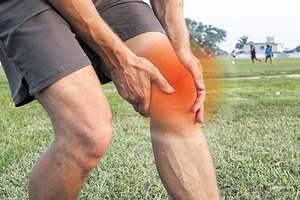The quadriceps muscle is a hip flexor and lower-leg extensor. It becomes strained, damaged and weakened through activities such as squatting, running, jumping and climbing. The patient with patellar tendonitis complaints of knee pain just below the kneecap and/or on the tibial tuberosity when kneeling. The onset of pain is typically acute, but it may have a gradual progression.
Diagnosis
Evaluate knee range of motion bilaterally by having the patient squat fully until their buttocks touch the heels or are as closely approximated as possible. Limitations and pain during squats can be caused by ankle stiffness, patellar tendon dysfunction or excess muscle tension in the quadriceps, hamstrings and calves.
Muscle test bilaterally and note the deficiency of the involved quadriceps. To locate the fibers that are most strained, palpate the tendon insertion along the inferior border of the patella and at the tibial tuberosity for the points of maximal tenderness.
Various knee conditions need to be differentiated from patellar tendonitis. Pre-patellar bursitis (aka carpet layer's knee, housemaid's knee or nun's knee) is an inflammation at the front of the knee that commonly occurs among individuals whose professions require frequent kneeling. Patellofemoral pain syndrome (runner's knee) is characterized by pain originating from the contact of the posterior surface of the patella with the femur. Plica occurs when an extension of the synovial capsule of the knee becomes irritated, enlarged or inflamed.
Correction of the patellar tendon can be achieved by pressing the tendon fibers directly into the patella and tibia at the site of maximum tenderness. This has been shown to stimulate positive osteoblastic activity, which stabilizes the osteotendinous connection.1 You can also utilize an adjusting instrument to correct the strained tendon fibers by directing the instrument to impulse into the tender fibers.
Post-treatment evaluation should note increased strength and range of motion / function, and decreased pain.
Rehabilitation
Repeatedly correcting the tendon to strengthen the connection between the bone and tendon fibers promotes faster healing of the injured tissues. I encourage my patients to ice the region first and then press into the tender fibers several times a day.
Reference
- Taylor AF, Saunders MM, Shingle DL, et al. Mechanically stimulated osteocytes regulate osteoblastic activity via gap junctions. Am J Physiol Cell Physiol, 2007 Jan;292(1):C545-52.
Dr. Todd Turnbull, has authored online courses and articles about concussions, sports performance, soft-tissue diagnosis, rehabilitation and disc herniations. He is a 1991 graduate of Life University, a board-certified chiropractic sports physician, and maintains a private practice in Portland, Ore. He can be contacted with questions or comments via his Web site: www.drtoddturnbull.com/DCJournal.





